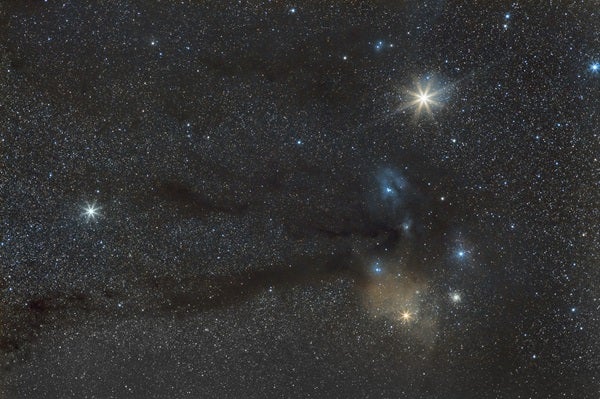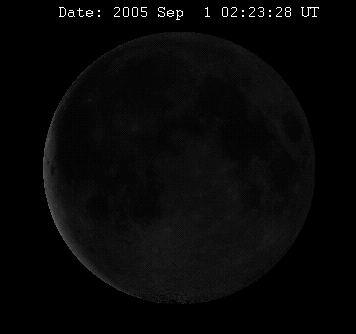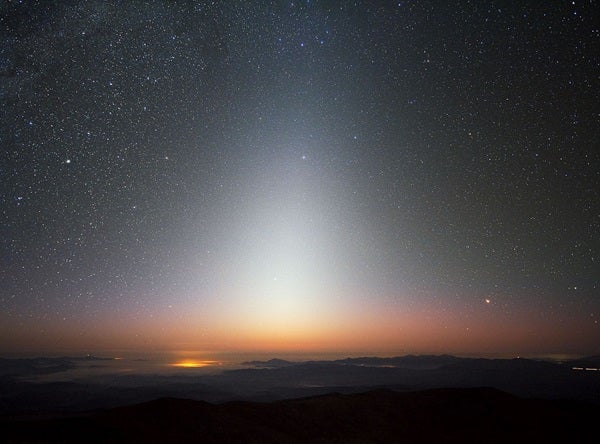Friday, August 26
• A trio of bright objects adorns the south-southwestern sky during evening twilight. Mars shines brightest, at magnitude –0.4, followed by magnitude 0.4 Saturn and then 1st-magnitude Antares, the brightest star in the constellation Scorpius the Scorpion. The three stand about 25° high an hour after sunset and remain on view until after 11 p.m. local daylight time. This evening, the Red Planet resides 2° north-northeast of Antares and 4° south of Saturn. Although the grouping looks best with the naked eye and binoculars, both planets are also worth viewing through telescopes. Mars’ orange-red disk spans 11″ and shows several subtle dark markings, while Saturn measures 17″ across and its dramatic ring system stretches 38″ and tilts 26° to our line of sight. As a bonus, the ringed planet reaches quadrature one week from today, which signifies that a line from the Sun to Earth and then to Saturn forms a right angle. Observationally, this means that Saturn’s shadow extends farthest east of the planet and shows up plainly on the rings, giving the world a striking 3-D appearance.
Saturday, August 27
• Venus and Jupiter lie closer to each other today than at any time since May 2000. At their tightest, just 4.2′ separate them. Unfortunately, this happens in late afternoon from North America. By twilight, the two worlds have pulled slightly apart — 5.5′ from the East Coast and 12.1′ from the West Coast. Still, that’s close enough that many people will see the two merge into one. Binoculars will provide spectacular views, clearly splitting the pair and revealing Mercury 5° to their lower left and just above the horizon. Most telescope-eyepiece combinations will show Venus and Jupiter in the same field, with Jupiter spanning 31″ and Venus 11″. Coincidentally, NASA’s Juno spacecraft makes its closest approach to Jupiter today when it flies within 2,500 miles (4,200 kilometers) of the giant planet’s cloud tops.
Sunday, August 28
• If you look overhead as darkness falls anytime this week, your eyes will fall on the brilliant star Vega in the constellation Lyra the Harp. At magnitude 0.0, Vega is the brightest member of the prominent Summer Triangle asterism. The Triangle’s second-brightest star, magnitude 0.8 Altair in Aquila the Eagle, lies some 35° southeast of Vega. The asterism’s dimmest member, magnitude 1.3 Deneb in Cygnus the Swan, stands about 25° east-northeast of Vega. Deneb trails Vega by about two hours and passes through the zenith at approximately 11 p.m. local daylight time.
Monday, August 29
• The variable star Algol in Perseus reaches minimum brightness at 4:02 a.m. EDT. If you start watching it on the evening of the 28th (it rises in the northeast around 9 p.m. local daylight time), you can see its brightness diminish by 70 percent over the course of about 5 hours as its magnitude drops from 2.1 to 3.4. This eclipsing binary star runs through a cycle from minimum to maximum and back every 2.87 days.
Tuesday, August 30
• The constellations Ursa Major the Great Bear and Cassiopeia the Queen lie on opposite sides of the North Celestial Pole, so they pivot around the North Star (Polaris) throughout the course of the night and the year. In late August and early September, these two constellations appear equally high as darkness falls. You can find Ursa Major and its prominent asterism, the Big Dipper, about 30° above the northwestern horizon. Cassiopeia’s familiar W-shape, which currently lies on its side, appears the same height above the northeastern horizon. As the night progresses, Cassiopeia climbs above Polaris while the Big Dipper swings below it.
Wednesday, August 31
• The Aurigid meteor shower peaks before dawn. Although this minor shower typically produces only 6 meteors per hour under optimal conditions, it occasionally performs much better. Rates six times higher than normal occurred in 1935, 1986, and 1994, and viewers recorded up to 130 meteors per hour in 2007. No one knows when the shower will erupt again, but with New Moon arriving tomorrow, conditions couldn’t be better for checking the shower out.
Thursday, September 1
• New Moon occurs at 5:03 a.m. EDT. At most New Moons, our satellite tracks across the sky with the Sun and remains hidden from view. But today, the alignment between the Moon and Sun is perfect. People along a narrow path that cuts across central and southern Africa can view an annular solar eclipse, in which the Moon appears completely inside the Sun’s disk and only a ring of sunlight remains visible. The path of annularity crosses from Gabon to Mozambique and then to Madagascar. At maximum eclipse in southern Tanzania, the annular phase lasts 3 minutes and 5 seconds. Remember to protect your eyes throughout this eclipse by using a safe solar filter.
Friday, September 2
• Neptune reaches opposition and peak visibility today. Because it lies opposite the Sun in our sky, it rises at sunset and appears highest in the south around 1 a.m. local daylight time. But you can start searching for it by 10 p.m., when it lies nearly one-third of the way from the southeastern horizon to the zenith. Neptune glows at magnitude 7.8, bright enough to spot through binoculars if you know where to look. The trick is to find the 4th-magnitude star Lambda (l) Aquarii, which lies about 10° southeast of Aquarius’ distinctive Water Jar asterism. At opposition, Neptune appears 1.3° southwest of this star. When viewed through a telescope, Neptune shows a blue-gray disk measuring 2.4″ across.
Saturday, September 3
• Look to the western sky shortly after sunset this evening and you’ll see a beautiful alignment of the Moon with Venus and Jupiter. Our satellite, which reached its New phase just two days ago, now appears 7 percent lit and stands highest. The three objects form a straight line spanning some 14°, with Venus midway between the other two.
Sunday, September 4
• The Moon’s absence from the morning sky these next ten days provides observers with an excellent opportunity to see the zodiacal light. From the Northern Hemisphere, the time around the autumnal equinox is the best for viewing the elusive glow before sunrise. It appears slightly fainter than the Milky Way, so you’ll need a clear moonless sky and an observing site located far from the city. Look for a cone-shaped glow that points nearly straight up from the eastern horizon shortly before morning twilight begins (around 5 a.m. local daylight time at mid-northern latitudes). The Moon remains out of the morning sky until September 14, when the waxing gibbous returns and overwhelms the much fainter zodiacal light.












